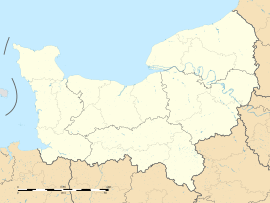Saint-Julien-de-Mailloc facts for kids
Quick facts for kids
Saint-Julien-de-Mailloc
|
|
|---|---|
| Country | France |
| Region | Normandy |
| Department | Calvados |
| Arrondissement | Lisieux |
| Canton | Orbec |
| Intercommunality | Pays de l'Orbiquet |
| Area
1
|
6.18 km2 (2.39 sq mi) |
| Population
(1999)
|
369 |
| • Density | 59.71/km2 (154.6/sq mi) |
| Time zone | UTC+01:00 (CET) |
| • Summer (DST) | UTC+02:00 (CEST) |
| INSEE/Postal code |
14599 /14290
|
| Elevation | 67–173 m (220–568 ft) (avg. 170 m or 560 ft) |
| 1 French Land Register data, which excludes lakes, ponds, glaciers > 1 km2 (0.386 sq mi or 247 acres) and river estuaries. | |
Saint-Julien-de-Mailloc was a small French town, also known as a "commune." It was located in the northwest of France, in a region called Basse-Normandie. This area is part of the Calvados department. On January 1, 2016, Saint-Julien-de-Mailloc joined with other nearby towns to form a new, larger commune called Valorbiquet.
Contents
What is Saint-Julien-de-Mailloc?
Saint-Julien-de-Mailloc was once a "commune." In France, a commune is like a local government area, similar to a town or a small city. It has its own mayor and manages local services. Saint-Julien-de-Mailloc was a very small commune. In 1999, only 369 people lived there.
Where Was It Located?
Saint-Julien-de-Mailloc was found in the Basse-Normandie region of France. This region is in the northwest part of the country. It was also part of the Calvados department. Departments are like counties in other countries. The town was located about 170 meters (558 feet) above sea level. Its total area was about 6.18 square kilometers (2.39 square miles).
Becoming Part of Valorbiquet
On January 1, 2016, Saint-Julien-de-Mailloc stopped being a separate commune. It merged with other nearby communes to create a new, bigger commune called Valorbiquet. This kind of merger happens when small towns decide to join together. They do this to share resources and manage things more easily.
Why Towns Merge
Towns sometimes merge to become more efficient. By joining together, they can share services like schools, libraries, or public works. This can help save money and provide better services for everyone. It also helps them have a stronger voice when dealing with bigger government levels.
See also
 In Spanish: Saint-Julien-de-Mailloc para niños
In Spanish: Saint-Julien-de-Mailloc para niños



